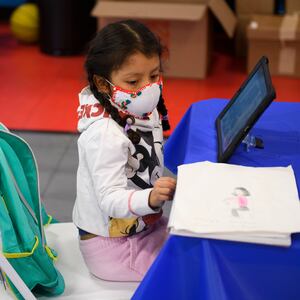We are finally beginning to peek around the COVID corner and cannot yet see what the post-pandemic world holds. There remain many unknowns, but at least one certainty: our children have suffered, all of them. And, once again, our educational system finds itself at the center of large social problems.
The cumulative effects of COVID on our children are deep: lockdowns, anxiety, insecurity, isolation, Zoom-school, closed schools, social distancing, the list goes on and on. Children were not just bystanders; they experienced first-hand the horrors of the pandemic as they suffered losses and watched their own families struggle. Add to this the political turmoil and social injustice of the past year, and we have a whole generation of children who have been shaped by COVID.
It is surely a COVID generation, but also without significant effort, they could become a lost generation.
ADVERTISEMENT
A December 2020 report from the consulting firm McKinsey reported that all students suffered learning lags ranging from three to six months. So, right out of the gate, we are seeing that the typical student is as much as half a grade level behind where she otherwise would have been. Most alarming, the report found the greatest harm is to students from underserved communities: “If the status quo continues,” writes McKinsey, as we now know that it has, “students of color stand to lose 11 to 12 months of learning by the end of this school year—compared to four to eight months for white students.”
The American Psychological Association reports that “missed instructional time is likely to be a serious setback for low-income students. Previous research has found that chronic absenteeism—usually defined as missing at least 10% of school days—affects reading levels, grade retention, graduation rates and dropout rates…. Chronic absenteeism disproportionately affects kids living in poverty in the best of times… [yet] remote learning during COVID-19 is likely to widen that disparity…”
How exactly will students catch up? Are K-12 schools even equipped and resourced for this herculean effort? Are we as a society ready for the investment needed for this lift? We better be, as the future of this country depends on it.
While much of the concern about lost school time has focused on younger students, I worry about those at the end of the K-12 journey, who have a shorter runway. What about those who graduate in the pandemic—what is their college experience? Can they handle the transition, which is never easy? And what about colleges themselves, are they ready to have half of all students enrolled (class of 2024 and 2025) arrive suffering all these ill-effects?
How will colleges and universities respond? Are they prepared, and if not, how can they be? Can faculty pivot and adjust their pedagogy to meet the new challenges? Do campuses have the mental health support necessary? And while high school seniors are now ready to decide where to go, what can they and their parents do to choose wisely?
We need to do more than worry about students whose last two years of high school were shaped by the pandemic. We need a concrete strategy to meet them and build them up. That is now the present reality of higher ed, like it or not. And parents should be asking an important set of questions to gauge a university’s seriousness and commitment to these students.
These are simple questions really. Tell me about your health center, the mental health services available, and your center for teaching and learning? The first two make sense, but for many, the last one might seem like it comes from left field. But it is a seriously important matter. Many universities have these centers, called by many names, that were designed as a resource to support innovation and excellence in teaching. At too many universities, however, these centers have been marginalized, diminished, and ignored. And, to meet the new challenges in higher ed, these centers will be critically important.
Now is the time for higher education and states to invest in student learning, and these centers of learning should be one of the first priorities. Faculty can not do this alone. And without the help of adjacent learning professionals, students will continue to suffer.
Let’s remember that it is more than just learning that has suffered. Students come to class with lots of baggage. According to Insidehighereduction.com, students have missed important milestones: “Amy Bintliff, a developmental psychologist…, said that mismatch between expectation and reality can be difficult for students. Part of that is because important milestones, like graduation, can’t happen the way they were envisioned. Traditional-age students may struggle uniquely with the loss of certain coming-of-age experiences.”
College students, according to a Higher Ed Today study of first-year students (ages 18 to 20), experience “moderate-severe anxiety increased from 18.1 percent before the pandemic (October 2019-February 2020) to 25.3 percent within four months after the pandemic began (June/July 2020). Similarly, researchers find that moderate-severe depression increased from 21.5 percent to 31.7 percent.” That means that 50 percent of college students report moderate-to-severe anxiety and depression. That is on its face is a massive public health crisis.
College students have also been financially impacted. According to the Hechinger Report, “6.6 million students can’t obtain their transcripts from public and private colleges and universities that block them from access for having unpaid balances as low as $25 or less.” Imagine students who cannot get their diploma or transcripts because they can’t gather the $25 needed to pay that outstanding bill. A significant number of students are also food insecure. According to a survey conducted by Hope4College, 39 percent of the college students surveyed were food insecure during the prior 30 days, 46 percent were housing insecure in the past year, and 17 percent were homeless in the past year. This is sobering.
What this picture tells us is that we have an outdated image of college that needs to change. It is rooted in a romantic, mythical past that still imagines campuses of 18- to 22-year-olds on an idyllic, residential campus. Today more than 50 percent of all students are older than college age. They are juggling families, bills, and work while trying hard to advance their career opportunities. Many do not make it to graduation. And COVID is not just causing delays. According to Marketplace, the pandemic has seen a significant decline in college going for students of color. And, as they report, “That has repercussions now and for the future.”
UNICEF calls the tragedy before us “a trifecta of threats: direct consequences of the disease itself, interruption in essential services and increasing poverty and inequality.”
College and universities need to rethink how they approach this generation, understanding the deep trauma and educational impact caused by the pandemic. Geoff Mills, writing in the UK’s Times Higher Education says “these times … have been tough on almost everyone’s mental health and have pushed issues of personal well-being to the fore. But they have also shown that, with just cause, it is possible to dramatically transform the way university courses are taught at very short notice. These two factors make now the right time for universities to put mental well-being at the forefront of their curriculum design and delivery.”
Looking at our students as we find them, reimagining how we can walk with them on their educational journey, is not new for most college faculty. Now is the time for institutions of higher education to invest in faculty, support them as they develop new methodologies and use new technologies for teaching. And, if we really care, states need to reinvest in their public systems and the place to start, the one that will have the quickest route to impact, would be to jump-start centers for teaching and learning.






